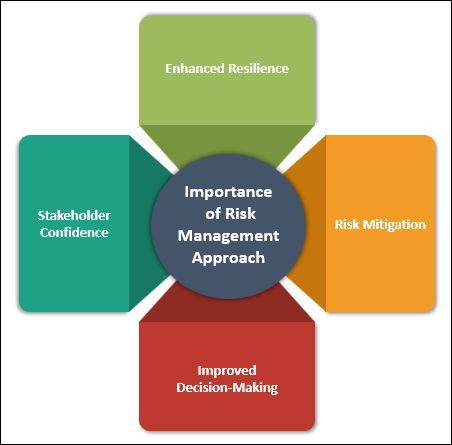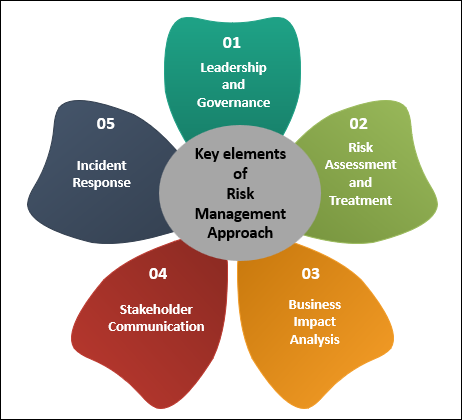Risk Management Approach for 22301
ISO 22301 is an internationally recognized standard that provides organizations with a structured framework for building a resilient and effective business continuity management system. In today's complex and unpredictable business environment, organizations face a multitude of risks, ranging from natural disasters to cyber threats, which can disrupt operations and impact their ability to deliver products and services. ISO 22301 offers a systematic approach to identifying, assessing, and mitigating these risks, enabling businesses to not only survive disruptions but also thrive in their aftermath.
This standard emphasizes the importance of proactive risk management, ensuring that an organization can continue its critical functions during and after disruptive events. ISO 22301 provides guidelines for creating a business continuity plan, establishing recovery strategies, and enhancing an organization's ability to respond to and recover from various incidents. By adopting ISO 22301, companies can bolster their resilience, minimize downtime, and maintain customer trust even in the face of adversity. This introductory standard is a vital tool for modern businesses committed to safeguarding their operations and ensuring their long-term sustainability.
Importance of ISO 22301:Risk Management Approach for 22301
- Enhanced Resilience: ISO 22301 is vital for organizations looking to enhance their resilience. It provides a structured approach to identify, assess, and mitigate risks, ensuring that businesses can effectively manage disruptions and maintain essential operations.
- Risk Mitigation: This standard helps organizations proactively address potential threats, whether they are natural disasters, supply chain interruptions, or cybersecurity breaches. By mitigating risks, businesses can prevent costly downtime and loss of revenue.
- Business Continuity: ISO 22301 promotes the development of a robust business continuity plan, ensuring that organizations have strategies in place to continue operations during and after disruptive events. This is crucial for maintaining customer trust and market competitiveness.
- Compliance and Credibility: Achieving ISO 22301 certification demonstrates a commitment to best practices in risk management and business continuity. This can enhance an organization's credibility and trustworthiness in the eyes of customers, partners, and regulators.
- Cost Savings: Effective risk management through ISO 22301 can lead to significant cost savings. By identifying and addressing potential risks, organizations can reduce the financial impact of disruptions and avoid costly recovery efforts.
- Customer SatisfacCompetitive Advantage: tion: ISO 22301 helps businesses maintain consistent service delivery even during adverse circumstances. This translates to higher customer satisfaction and retention, as customers can rely on the organization's ability to meet their needs regardless of external challenges.
- Legal and Regulatory Compliance: Many industries have specific legal and regulatory requirements related to risk management and business continuity. ISO 22301 can help organizations meet these obligations and avoid potential legal issues.
- Improved Decision-Making: The risk management approach outlined in ISO 22301 encourages data-driven decision-making. Organizations can use the insights gained from risk assessments to make informed choices about resource allocation and strategy.
- Stakeholder Confidence: ISO 22301 provides a framework for engaging stakeholders, including employees, customers, and suppliers, in the business continuity process. This fosters confidence among all parties that the organization is well-prepared for any potential disruptions.
Key elements of ISO 22301:Risk Management Approach for 22301
- Context of the Organization: ISO 22301 emphasizes the importance of understanding the organization's internal and external context. This includes identifying stakeholders, legal and regulatory requirements, and the business environment, all of which can impact risk management and business continuity planning.
- Leadership and Governance: Effective leadership is essential for successful risk management. ISO 22301 requires commitment from top management, ensuring that they provide clear direction, allocate resources, and promote a culture of risk awareness and preparedness throughout the organization.
- Risk Assessment and Treatment: This standard mandates a systematic approach to risk assessment, which involves identifying, analyzing, and evaluating potential threats. Afterward, organizations must develop and implement risk treatment plans to mitigate or eliminate identified risks.
- Business Impact Analysis: ISO 22301 stresses the need to perform a Business Impact Analysis (BIA). This process identifies critical functions, their dependencies, and the potential impact of disruptions. It forms the basis for developing a business continuity plan.
- Business Continuity Planning: Organizations are required to develop and maintain a comprehensive business continuity plan that outlines strategies, responsibilities, and procedures for ensuring the continuity of critical operations during and after disruptions.
- Recovery and Restoration: ISO 22301 focuses on the recovery and restoration of operations. It guides organizations in developing recovery strategies, including IT recovery, facilities recovery, and workforce recovery, to minimize downtime and ensure a swift return to normal operations.
- Testing and Exercises: Regular testing and exercises are crucial to validate the effectiveness of the business continuity plan. ISO 22301 mandates testing scenarios, including tabletop exercises, simulations, and full-scale tests to identify areas for improvement.
- Performance Monitoring and Measurement: Organizations must establish Key Performance Indicators (KPIs) to monitor and measure the performance of their business continuity management system. This allows for ongoing improvement and ensures that the system remains effective.
- Documentation and Records: Proper documentation is a key element of ISO 22301. Organizations must maintain records of risk assessments, business continuity plans, test results, and other relevant information to demonstrate compliance and facilitate audits.
- Stakeholder Communication: Effective communication with internal and external stakeholders is essential. ISO 22301 outlines requirements for establishing communication processes to ensure that all relevant parties are informed and engaged during disruptions.
- Training and Awareness: Employees play a critical role in effective risk management and business continuity. ISO 22301 emphasizes the importance of training and raising awareness among employees, ensuring they understand their roles and responsibilities in the event of a disruption.
- Incident Response: The standard requires organizations to have a well-defined incident response structure to manage and escalate incidents as necessary. This includes the activation of the business continuity plan when needed.
- Supply Chain Management: ISO 22301 recognizes the importance of supply chain resilience. It encourages organizations to assess and address risks within their supply chains, ensuring that suppliers and partners are also adequately prepared for disruptions.
The Benefits of ISO 22301:Risk Management Approach for 22301
- Enhanced Resilience: ISO 22301 helps organizations build resilience to various risks and disruptions. This translates to a reduced likelihood of business interruptions and a quicker recovery from incidents, ultimately saving time and resources.
- Minimized Downtime: By developing and implementing a robust business continuity plan, organizations can significantly reduce downtime during disruptions. This results in improved operational continuity and a more consistent delivery of products and services to customers.
- Cost Savings: Effective risk management and business continuity planning through ISO 22301 can lead to substantial cost savings. This includes reduced recovery costs, lower insurance premiums, and decreased revenue loss during downtime.
- Competitive Advantage: Organizations that demonstrate ISO 22301 compliance gain a competitive advantage in the market. Customers, partners, and investors often favor businesses that prioritize risk management and business continuity, as it instills confidence in their ability to deliver under any circumstances.
- Customer Trust and Loyalty: ISO 22301 helps organizations maintain customer trust and loyalty by ensuring the continuity of critical services. Customers are more likely to remain loyal when they know a business can weather disruptions and continue to meet their needs.
- Regulatory Compliance: Many industries have specific regulations related to risk management and business continuity. ISO 22301 can assist organizations in meeting these legal and regulatory requirements, reducing the risk of fines and legal issues.
- Improved Decision-Making: The risk assessment process outlined in ISO 22301 provides organizations with valuable insights into their vulnerabilities and dependencies. This information can lead to more informed and data-driven decision-making across the organization.
- Stakeholder Confidence: ISO 22301 encourages engagement with stakeholders, including employees, customers, and suppliers. By involving these parties in the business continuity process, organizations can foster greater confidence and collaboration during disruptions.
- Supply Chain Resilience: ISO 22301 extends its benefits to supply chain management. Organizations can work with suppliers and partners to ensure their own resilience, reducing the risk of supply chain disruptions and ensuring a more reliable flow of goods and services.
- Continuous Improvement: The standard promotes a culture of continuous improvement. Organizations regularly review and update their risk assessments, business continuity plans, and response strategies, allowing them to adapt to changing risks and circumstances.
- Enhanced Organizational Learning: Through testing and exercises, ISO 22301 helps organizations identify areas for improvement. This leads to a culture of organizational learning and adaptability, increasing the effectiveness of the business continuity management system.
- Reduced Reputation Risk: Effective risk management can mitigate reputation damage. ISO 22301 helps organizations respond to incidents in a way that minimizes the negative impact on their brand and public image.
- Global Recognition: ISO 22301 is an internationally recognized standard. Achieving certification demonstrates a commitment to best practices in risk management and business continuity, enhancing the organization's global recognition.
Conclusion
In conclusion, ISO 22301 stands as a cornerstone in the realm of risk management and business continuity. It offers organizations a systematic and globally recognized framework to navigate the unpredictable waters of disruptions and unforeseen challenges. By diligently adhering to the principles and practices outlined in this standard, businesses can cultivate a culture of resilience, ensuring the sustained delivery of products and services, even in the face of adversity.
ISO 22301 empowers organizations to identify, assess, and mitigate risks, thus minimizing costly downtime, preserving customer trust, and staying ahead of competitors. The benefits extend far beyond the immediate impact of disruptions, encompassing financial savings, regulatory compliance, and a strengthened reputation. This standard not only fosters operational continuity but also paves the way for informed decision-making and constructive stakeholder engagement.



